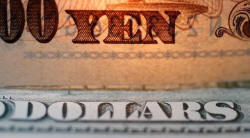|
Dollar hits five-month
low vs. yen as North Korea tensions mount
 Send a link to a friend
Send a link to a friend
 [April 17, 2017]
By Shinichi Saoshiro [April 17, 2017]
By Shinichi Saoshiro
TOKYO
(Reuters) - The dollar dipped to a five-month low against the yen on
Monday as rising tensions over North Korea kept the safe-haven Japanese
currency in demand.
The dollar index against a basket of major currencies was down 0.2
percent at 100.390 <.DXY>, weighed down following the release of
Friday's weak U.S. retail sales and consumer prices data and as
flight-to-safety drove U.S. Treasury yields to five-month lows.
The U.S. currency extended losses from the previous day and retreated to
108.135 yen <JPY=>, its lowest since mid-November.
The yen remained broadly bid against other currencies as well. The euro
and the pound slid to five-month troughs of 114.955 yen and 136.05 yen,
respectively.
Increasing geopolitical risks another notch, North Korea on Sunday made
what was believed to be a failed missile test launch. Regional tensions
have risen over the past weeks as U.S. President Donald Trump has taken
a tough rhetorical line with Pyongyang.
"It is unclear whether the situation over North Korea will escalate into
military action, but uncertainty is increasing and the dollar continues
to edge lower. The dollar also looks shaky technically, after slipping
below the 200-day moving average of 108.80 yen," said Masafumi Yamamoto,
chief currency strategist at Mizuho Securities in Tokyo.

Japan's proximity to the Korean Peninsula, however, means that the yen's
safe-haven status could be eroded if tensions between Washington and
Pyongyang escalated into open conflict.
"Right now the markets are still functioning, with the reaction to the
situation being weaker equities, lower Treasury yields and the yen
firming against the dollar," said Koji Fukaya, president at FPG
Securities in Tokyo.
"But it could be an entirely different matter should an international
emergency actually take place," he added, reckoning that the dollar
could benefit due to its position as the world's principal reserve
currency.
With the bulk of the market's focus on how the standoff between the
United States and North Korea will play out, the semi-annual U.S.
Treasury currency report released late on Friday did not receive as much
attention as some had initially expected.
The
Trump administration declined to name any major trading partner as a currency
manipulator in the highly-anticipated report on Friday, backing away from a key
Trump campaign promise to slap such a label on China.
[to top of second column]
 |

The word "Yen" is pictured on a Japanese banknote on top of a U.S.
dollar bill at Interbank Inc. Money exchange in Tokyo, Japan in this
September 9, 2010 picture illustration. REUTERS/Yuriko Nakao/File
Photo

The U.S. Treasury, however, ensured that currency policies would remain a
sticking point going forward by keeping China, Germany and Japan on a
"monitoring list."
"Market reaction, if there was one, to the currency report has already faded.
The U.S. Treasury does not look like it will take a strong stance on currencies.
But in the case of the Trump administration the market will need to watch out
for what his trade advisors may have to say on this issue," said Yamamoto at
Mizuho Securities.
The euro was a shade higher at $1.0622, having spent the previous session in a
very tight range.
Wariness over the first round of the French presidential elections on April 23,
another potential source of geopolitical risk keeping global markets nervous,
was expected to cap the common currency this week.
The Australian dollar added 0.1 percent to $0.7588 while the New Zealand dollar
rose 0.4 percent to $0.7030.
The risk-sensitive Aussie and kiwi fell to three- and one-month lows,
respectively, in the middle of last week. But they have pulled back on upbeat
local economic indicators and as the greenback fell broadly on Trump's comments
that the dollar was getting too strong.

Currencies, including the Australian dollar, which tends to react to the
economic fortunes of China, showed little response to data showing the Chinese
economy grew at a slightly faster-than-expected 6.9 percent in the first
quarter.
(Editing by Sam Holmes)
[© 2017 Thomson Reuters. All rights
reserved.] Copyright 2017 Reuters. All rights reserved. This material may not be published,
broadcast, rewritten or redistributed. |